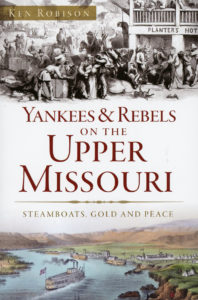
Great Falls historian Ken Robison continues to trace the tumultuous times before, during and after the Civil War in Montana Territory with a look at the Missouri River, and the steamboats that plied it with massive cargoes of freight and travelers, en route to new opportunities.
Fort Benton – where Robison is a historian with the Overholser Historical Research Center – is “a small town with a big history.” A hub that connected the Missouri River to the newly minted Mullan Road, it became a destination for miners, freight-haulers, pioneers and freedom seekers.
In a scant seven years, from 1860-67, Fort Benton boomed from a quiet, orderly trading post to a town that boasted “the bloodiest block in the West,” with brothels, saloons, gambling houses and dance halls open ‘round the clock.
Steamboat travel and gold discoveries were largely responsible for this boom in business. Robison describes the challenges of navigating snags, rapids and scoundrels on the big river. He shares the stories of some of the early riverboat captains, like Capt. Grant Marsh; and recounts the lives of both Union and Confederate soldiers who had an impact on local history.
In a fascinating section titled “Cradled in Dixie,” Robison chronicles the experience of newly freed slaves and freedmen, seeking a less repressive life in the West. While some black Americans arrived as travelers, others were deckhands, stewards, cooks, cabin boys and chambermaids aboard the steamboats.
In “Memorable Characters and Outlaws,” he explores the mystery of whether the infamous brothers, Jesse and Frank James, and their accomplice, Cole Younger, spent several months in Montana Territory. He also reveals that Col. Everton Conger, who tracked down President Lincoln’s assassin, eventually served on Montana’s territorial supreme court and is buried in Dillon.
Robinson, who follows the adage that “history is best told through stories,” fills pages with first-person accounts of a turbulent time, and paintings and photographs of the remarkable people who settled in the grandeur of a sparsely settled frontier.
– Kristi Niemeyer